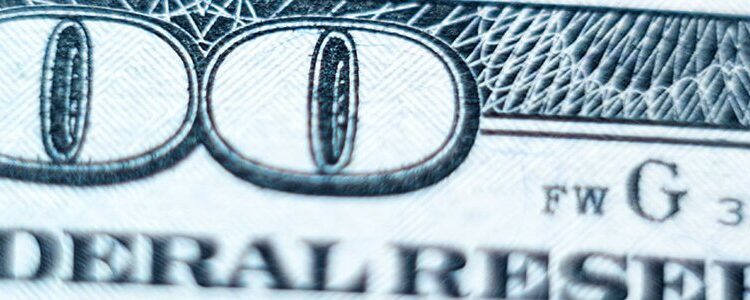U.S. Dollar Talking Points:
– The U.S. Dollar continued to pull back this week, finding support at the 200-day moving average.
– This can keep the door open for Dollar bulls but they’ll need to respond soon as bears are threatening to take control of intermediate-term price action. For next week, a continued hold at or around the 200-day moving average would be a key step for buyers trying to retain control.
– On the drivers front, there’s a speech from Christine Lagarde on Monday and rate expectations around the Euro can carry impact on the USD. For the U.S., it’s the Thursday release of Core PCE data that will likely garner the attention from the economic docket. And, as we saw last week, Fed-speak can be incredibly powerful, as it was the comment from Austan Goolsbee on the prior Wednesday about not getting ‘flipped out’ about a CPI report that seemed to spur themes of USD weakness, EUR/USD and XAU/USD strength; along with helping equities to hold support which led into this week’s massive equity moves.
– I’ll be discussing these themes in-depth in the weekly webinar. It’s free for all to register: Click here to register.
USD bulls took another step back this week as the pullback from the 105 zone in DXY continued. This has allowed for a support test at the 200-day moving average and that was the same spot that held resistance for almost three full weeks before buyers pushed to a higher-high in early-February trade.
This extends the theme that I’ve been talking about in webinars, where the ‘natural flow’ of the USD appears higher, as demonstrated by a continuation of higher-highs and higher-lows that have build for the past two months. That’s largely been driven by data, such as the NFP report earlier this month that finally allowed for the breakout over the 200-dma; and then the CPI report last week that prodded bulls up to another higher-high, eventually finding resistance just under the 105.00 level in DXY.
But the other side of the argument is that policymakers in the U.S. don’t seem to intimidated by the continued strength in U.S. economic data and they continue to talk up the prospect of rate cuts. I had highlighted this a few different times already, but it was just a day after that CPI report last week that Chicago Fed President Austan Goolsbee said that markets should avoid getting ‘flipped out’ about a single inflation print. That helped to bring a pullback into DXY that largely continued through this week, until support showed at prior resistance as taken from the 200-day moving average.
So, from the daily, price action retains a bullish lean given that hold of support at prior resistance, combined with the continuation of higher-highs and higher-lows. Coming in to hold the low this week was another pertinent level, as taken from the 50% retracement of last year’s bullish move. That plots at 103.46 and it helped to hold the lows this week. That would be the spot that bulls would need to defend to keep the door open for continuation through next week.
U.S. Dollar Daily Price Chart
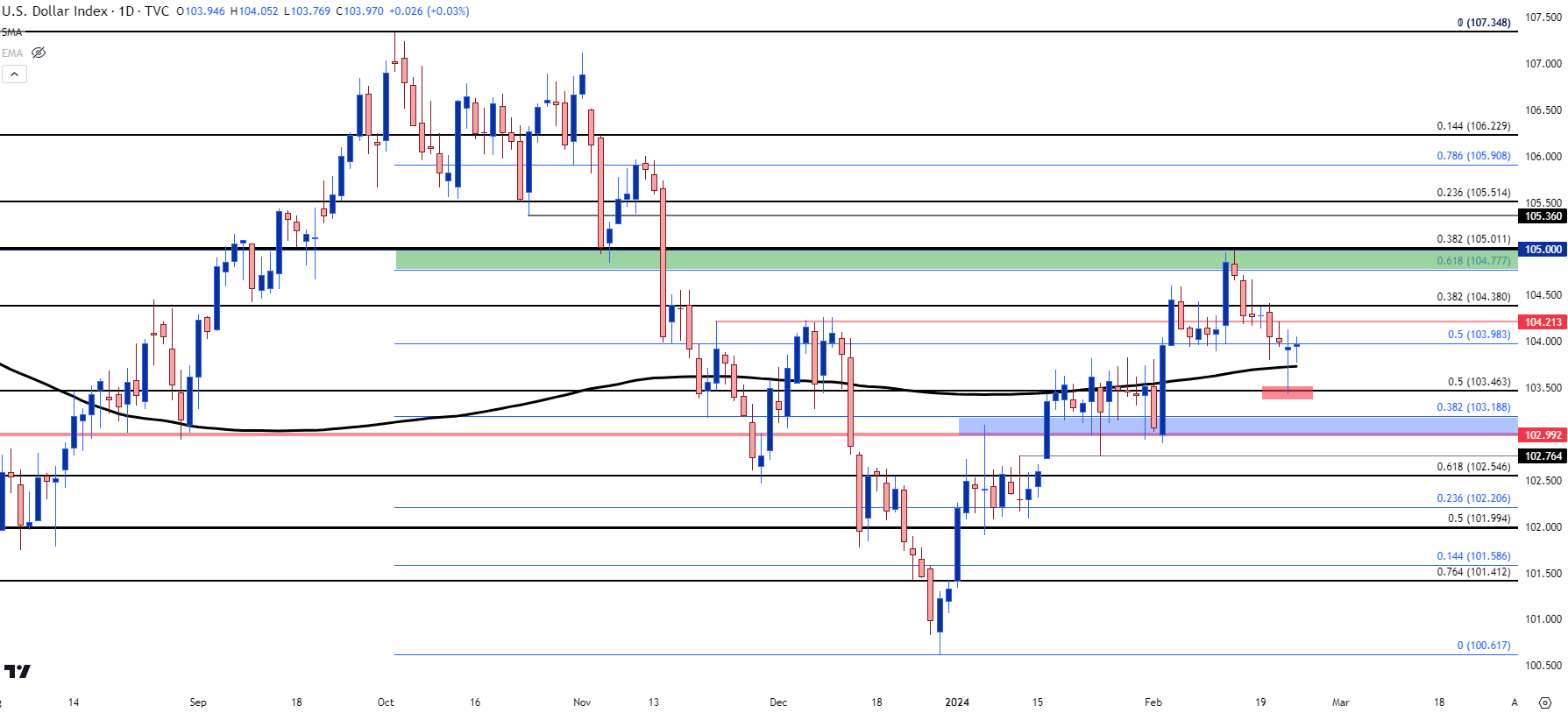 Chart prepared by James Stanley; data derived from Tradingview
Chart prepared by James Stanley; data derived from Tradingview
Euro
The European economy doesn’t appear to be in a great spot. Even going back to last year, former ECB President Mario Draghi said he would be surprised if the economy didn’t soon go into recession. And, more recently, we’ve started to hear of trouble in Germany with the German Finance Minister saying this week that the economy was in ‘troubled waters.’ He also cut the growth forecast for 2024 to 0.2% from a prior expectation of 1.3%. On the positive side, unemployment remains relatively low in Germany so there’s perhaps a bit less concern of recessionary tendencies given that the impact hasn’t been as widespread as it could be.
But, of special interest for Forex traders are spot rates and this is, perhaps, one explanation for why the ECB has seemed to be less-dovish than the Fed. If the Euro was to show a significant strain of weakness that could easily place upward pressure on inflation, which would hamstring the ECB quite a bit as the bank looks to cut rates later in the year. But this isn’t something isolated to Europe either, as a European recession would have consequence for the U.S. So, for now, it appears that both U.S. and European Central Banks are hoping for a stronger spot quote in EUR/USD.
We’ll hear more on that early next week when Christine Lagarde speaks to markets on Monday. And then the next major push point for this theme will be the Thursday release of Core PCE data.
If that comes out soft, USD bears could get some room to run and this could open the door for EUR/USD bulls. From the four-hour chart below, we can see that continued bullish structure that remains intact as of this writing.
This is the same chart that I had shared in the Wednesday webinar with no added annotations. But, we can also see that bullish theme continuing to develop as buyers pushed a breakout up to key resistance at 1.0886, after which the pullback held higher-low support.
EUR/USD Four-Hour Price Chart
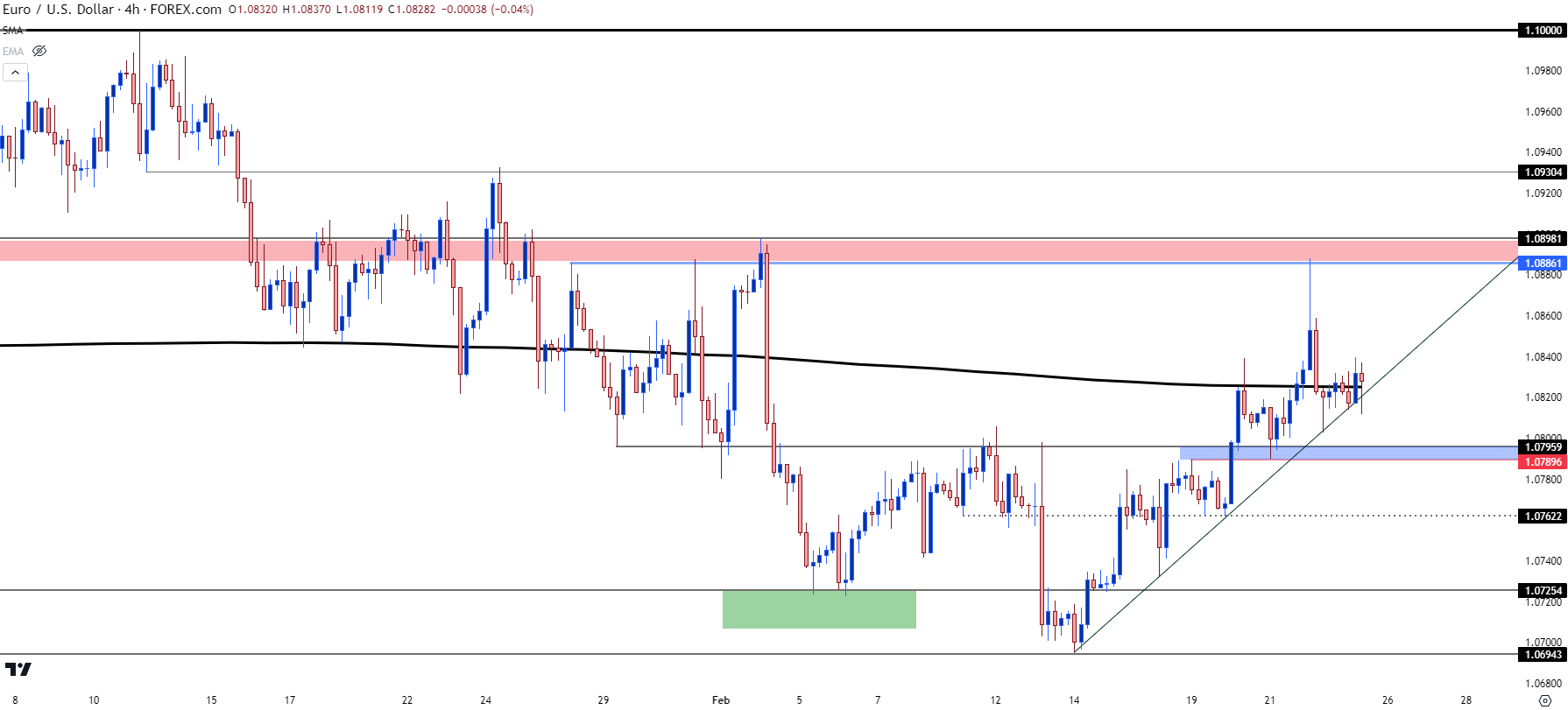 Chart prepared by James Stanley, EUR/USD on Tradingview
Chart prepared by James Stanley, EUR/USD on Tradingview
GBP/USD
Over the past couple of weeks in webinars, I’ve looked at GBP/USD as a area of interest for bearish USD-scenarios. There’s a couple of reasons for that, mainly rooted in price action.
Even as the USD pushed a bullish trend for much of the past two months, GBP/USD held strong, remaining in a range for much of that time. Like we saw in EUR/USD building a bearish trend, the fact that GBP/USD remained somewhat flat highlights how GBP strength offset USD strength, to a degree. And with U.K. inflation remaining higher than U.S. inflation, there could be reason for the Bank of England to be more-hawkish than the Fed, which can support strength in the pair.
From the GBP/USD chart, however, there was a false breakout in early-February, pushed by a spike of USD-strength that showed up after the U.S. NFP report. It took about a week, but bulls showed up to hold a higher-low and as I had looked at in last week’s webinar, the 200-day moving average was in a prime spot for that theme, as a hold of support on a daily basis – above the prior swing low – would constitute not only defense of the 200 but also a higher-low that could make themes of USD-weakness more attractive.
Now – the pair is pushing back to the resistance that’s proven tough over the past three months, and it runs between Fibonacci levels at 1.2720-1.2758. If the Core PCE release comes out soft, which would give USD-bears one of the first major data points to work off of with the benefit of the dovish push from the Fed, and GBP/USD could retain breakout potential.
GBP/USD Daily Chart
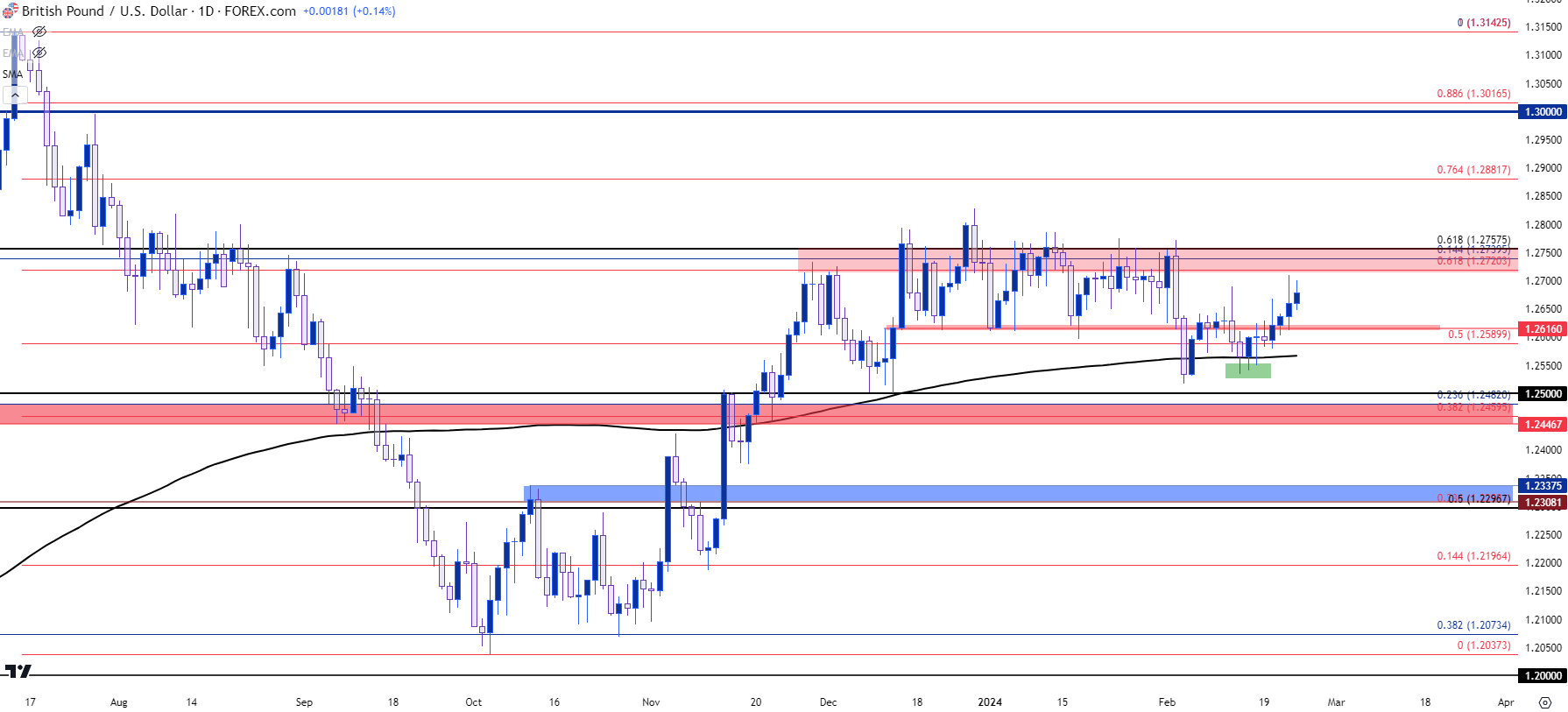 Chart prepared by James Stanley, GBP/USD on Tradingview
Chart prepared by James Stanley, GBP/USD on Tradingview
USD/JPY
The Japanese Yen also plays a large part in that DXY quote as the second biggest allocation at 13.6%. And while there’s been a recent tendency towards USD weakness since last Wednesday, that hasn’t been visible in USD/JPY as Yen-weakness has continued to outpace that of the U.S. Dollar.
Behind this is little expectation of change at the Bank of Japan, and with the country going back into recession last week, there may be even less reason for the BoJ to pose any near-term shifts to policy. Next week we’ll get another inflation print out of Japan, and that data point has been falling of late as it printed at 2.6% last month against the 2.8% of the prior month and the 3.3% of the month before that. The next print is released on Monday and that’s also expected to come in at 2.6%.
The one item that bears could have to work with is the prospect of intervention. We’ve already heard grumblings from the finance ministry and that’s likely one of the reasons that bulls haven’t forced a re-test of the 152.00 level that’s marked the high for the past two years.
If the Finance Ministry does order the BoJ to intervene, that doesn’t necessarily spell a doom-and-gloom reversal in the pair, such as we saw in 2022. That intervention merely pushed bulls off the ledge and support then held above 145 until, eventually, a major US driver brought on Dollar weakness and that’s when bullish carry traders started to relent.
So, if there is an early-week intervention to prod a pullback, that could retain a bullish posture. If the Core PCE report later in the week prods themes of USD-weakness, that’s when reversal potential could get more attractive, in my opinion.
USD/JPY Weekly Price Chart
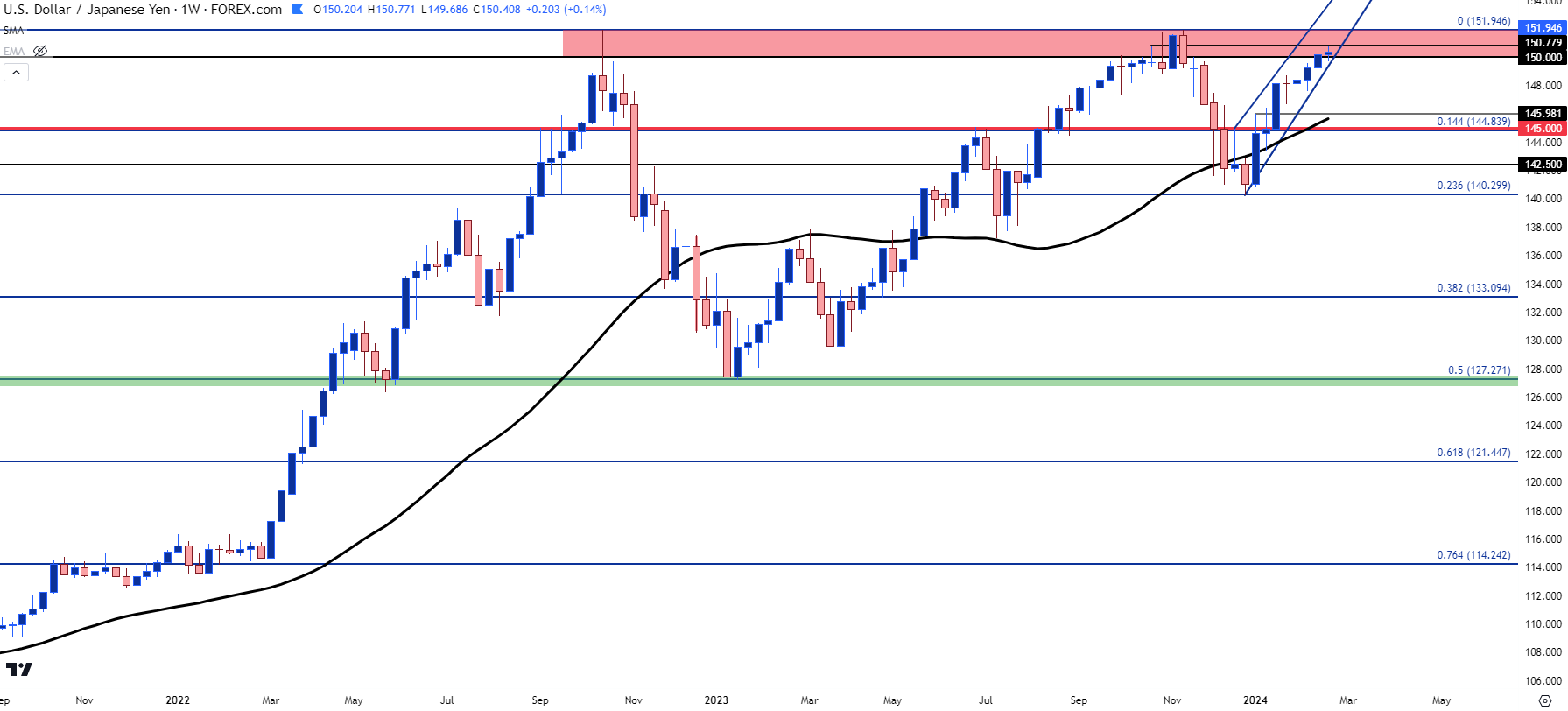 Chart prepared by James Stanley, USD/JPY on Tradingview
Chart prepared by James Stanley, USD/JPY on Tradingview
— written by James Stanley, Senior Strategist

